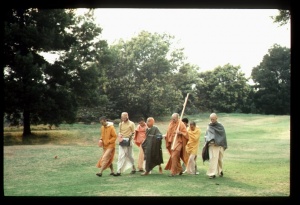CC Adi 16.31 (1975)

A.C. Bhaktivedanta Swami Prabhupada
Below is the 1996 edition text, ready to be substituted with the 1975 one using the compile form.
TEXT 31
- vyākaraṇa paḍāha, nimāñi paṇḍita tomāra nāma
- bālya-śāstre loke tomāra kahe guṇa-grāma
SYNONYMS
vyākaraṇa—grammar; paḍāha—You teach; nimāñi paṇḍita—Nimāi Paṇḍita; tomāra—Your; nāma—name; bālya-śāstre—in grammar, which is considered a study for boys; loke—the people in general; tomāra—of You; kahe—declare; guṇa-grāma—very much qualified.
TRANSLATION
“I understand that You are a teacher of grammar,” he said, “and that Your name is Nimāi Paṇḍita. People speak very highly of Your teaching of beginners’ grammar.
PURPORT
Formerly Sanskrit schools first taught grammar very thoroughly, and this system continues even now. A student was supposed to study grammar carefully for twelve years in the beginning of his life, because if one is expert in the grammar of the Sanskrit language, all the śāstras are open to him. Śrī Caitanya Mahāprabhu was famous for teaching grammar to students, and therefore Keśava Kāśmīrī first referred to His position as a teacher of grammar. Keśava Kāśmīrī was very proud of his literary career; he was far above the first lessons of grammar, and so he thought the position of Nimāi Paṇḍita not at all comparable to his own.